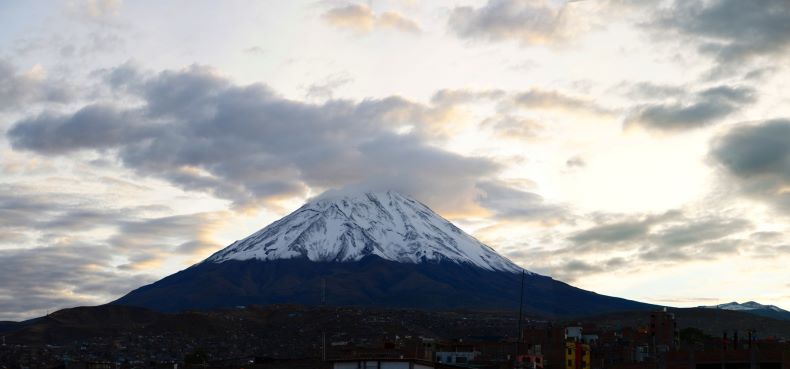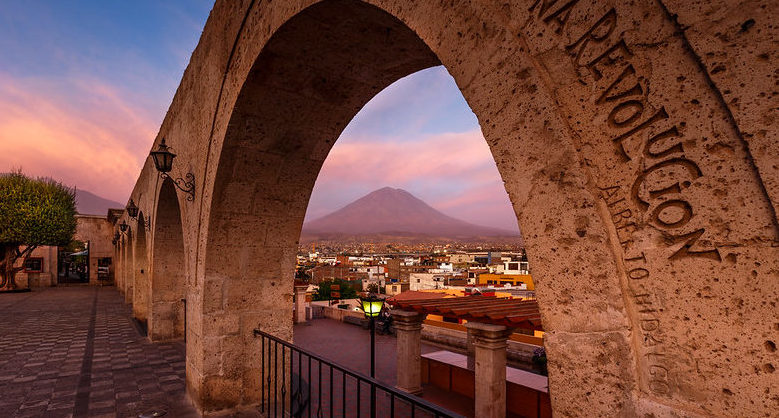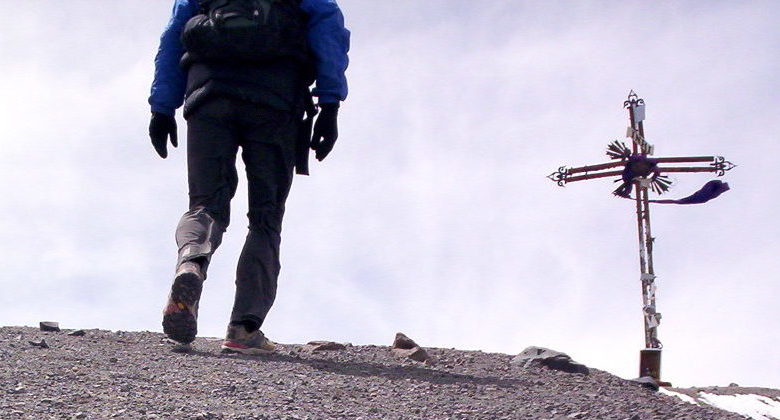Discover everything about the Misti Volcano in Peru and why you need to visit Arequipa to appreciate one of the most impressives volcanoes on Earth.

The Misti Volcano is one of the most imposing active volcanoes in the world and the most significant one in Peru. The breathtaking view from the city of Arequipa and many other locations makes it one of the main attractions for both Peruvian and international travelers. Although its last major eruption occurred many years ago, experts note that it has a long eruptive life ahead, categorizing it as a high-risk volcano.
All about the Misti Volcano:
Misti is a stratovolcano located in the southern part of the country, in the Arequipa region, and is one of over 16 volcanoes in Peru. Misti translates to ‘lord of white race’ in Quechua, closely related to the nickname of the neighboring city, Arequipa, known as the ‘white city’.
The ashes from the volcano’s eruptions formed what is known as ‘sillar’, a volcanic material used to build various architectures throughout the city of Arequipa and its surroundings.

The volcano is situated in the Chili River Valley, approximately 18 kilometers from the center of the city of Arequipa. It is worth noting that Misti is not the only volcano in the area, as it is surrounded by the Chachani and Pichu Picchu volcanoes.
Misti Volcano lies over 2,400 meters above sea level, with its maximum height reaching 5,882 meters. Its imposing presence can be appreciated from any point in the city, including the most popular viewpoint in Arequipa, Yanahuara.

Experts estimate that the volcano is approximately 800,000 years old. Over 2,000 years ago, one of its biggest eruptions occurred, reaching a level of 5 on a scale of 0 to 8, considered one of the most significant in the southern region of the country. Another eruption took place in the 15th century during the Inca period, when it was referred to as ‘apu’ (lord) due to its greatness and divinity. It is said that during the eruption, Inca Tupac Yupanqui offered prayers and sacrifices to appease the volcano’s wrath, without success.
During the colonial era, volcanic sillar was used to construct important places such as the Cathedral of Arequipa and the Santa Catalina Monastery located in the city.
Did you know…? In 1998, archaeologists discovered the remains of children’s bodies in the Misti crater, indicating ceremonial sacrifices during the Inca period.
In the last century, the volcano exhibited minor eruptions and significant fumaroles, a mixture of gases and steam from the volcano’s crater. While it is true that the volcano has not shown significant activity in recent years, specialists comment that it remains active, with a long life ahead, and could undergo eruptive processes at any time.
A major eruption would directly impact the population of Arequipa, which exceeds one million inhabitants. Around 50 daily earthquakes occur in the volcano, though they are imperceptible to the population.
Volcanoes |
El Misti |
Mount Vesuvius |
Colima |
Krakatoa |
Location |
Arequipa, Peru |
Naples, Italy |
Colima y Jalisco, Mexico |
Sunda Strait, Indonesia |
Elevation |
19,101 ft (5,882 m) |
4,203 ft (1,281 m) |
12,533 ft (3,960 m) |
515 ft (110 m) |
Age |
800,000 years |
400,000 years |
23,000 years |
1,600 years |
Last eruption |
1985 |
1944 |
2017 |
2023 |
Most famous eruption |
15th century |
79 BC |
1913, 2005 |
1883 |
The way to reach Misti is by trekking from the town of Chiguata or from the Aguada Blanca National Reserve.
If you choose to start from Chiguata, you’ll first need to reach this town by land transport, located 30 km from the city. From there, you can head to a campsite at the foothills of Misti and, the next day, begin the approximately 5-hour trek to the top of the crater.
The other option is to drive to the Aguada Blanca National Reserve, famous for its salt flats and home to vicuñas. A car journey to the reserve takes 3 hours, and the ascent on foot to Misti takes 8 hours, offering a more challenging alternative.

Travel Tip: Peru Hop is one of the best options for reaching Arequipa from any part of Peru. Check our tickets to Arequipa and plan your trip to this incredible city.
The weather at Misti is cold, with temperatures dropping to -15°C at night. The best time to visit Misti is from April to November when rainfall in the area is scarce.
If you plan to take a tour to Misti, we recommend acclimating for 1 or 2 days in the city to avoid altitude sickness. Don’t forget to bring the following:
Misti is undoubtedly one of the most famous volcanoes in Peru. During your time in Arequipa, make sure to have your camera ready and capture the best photos of the volcano from the city’s viewpoints. For more details about the city of Arequipa and what to do there, visit the official information website arequipa.com.